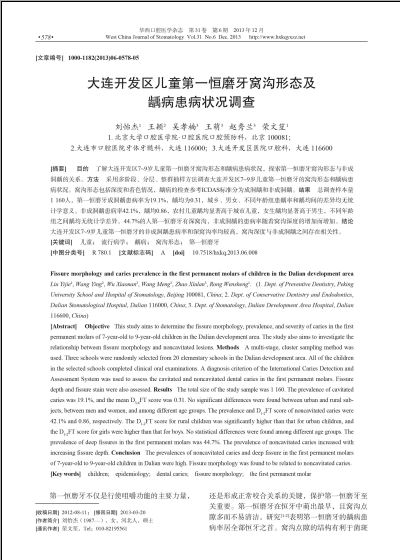大连开发区儿童第一恒磨牙窝沟形态及龋病患病状况调查(3)
 |
| 第1页 |
参见附件。
[7]Bader JD, Graves RC, Disney JA, et al. Identifying children who will experience high caries increments[J]. Community Dent Oral Epidemiol, 1986, 14(4):198-201.
[8]Sánchez-Pérez L, Golubov J, Irigoyen-Camacho ME, et al. Clinical, salivary, and bacterial markers for caries risk as-sessment in schoolchildren: a 4-year follow-up[J]. Int J Paediatr Dent, 2009, 19(3):186-192.
[9]Pitts NB, Stamm JW. International Consensus Workshop on Caries Clinical Trials (ICW-CCT)—final consensus sta-tements: agreeing where the evidence leads[J]. J Dent Res, 2004, 83(Spec C):C125-C128.
[10]Ba?eren NM, Gokalp S. Validity of a laser fluorescence system (DIAGNOdent) for detection of occlusal caries in third molars: an in vitro study[J]. JOral Rehabil, 2003, 30(12):1190-1194.
[11]谢毓秀, 吴奇光. 窝沟龋的早期诊断[J]. 华西口腔医学杂志, 2001, 19(3):158-160.
[12]Griffin SO, Oong E, Kohn W, et al. The effectiveness of sealants in managing caries lesions[J]. J Dent Res, 2008, 87(2):169-174.
[13]Borges BC, Campos GB, da Silveira AD, et al. Efficacy of a pit and fissure sealant in arresting dentin non-cavitated caries: a 1-year follow-up, randomized, single-blind, con-trolled clinical trial[J]. Am J Dent, 2010, 23(6):311-316.
(本文编辑 李彩)
您现在查看是摘要介绍页,详见PDF附件。